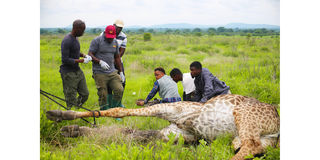Mysterious giraffe skin disease spreads across Tanzania's national parks

Researcher from TAWIRI examine one of the giraffe affected with skin disease
What you need to know:
- The disease which was first discovered in 2000 has now affected 62 percent of giraffes in Ruaha
Arusha. A strange skin disease is alarming wildlife conservationists across Tanzania, infecting over 60 percent of giraffes in Ruaha, Tarangire, and Serengeti National Parks.
According to a report by the Tanzania Wildlife Research Institute (TAWIRI), the disease appears endemic to southern Tanzania, but is now spreading northward. It first emerged in Ruaha's Lunda section in 2000 and has steadily expanded its reach.
Twenty-four years after the initial outbreak, researchers are returning to Ruaha to assess the effectiveness of interventions aimed at curbing the disease.
"In 2023, we isolated 18 giraffes for treatment," revealed Dr. Julius Keyyu, TAWIRI's Principal Researcher, "and we're here now to analyze the results."
Experts call the disease "giraffe skin disease," characterized by lesions, wrinkled skin, and crusting on limbs, shoulders, or necks. However, Dr. Keyyu notes that the strain affecting Tanzanian giraffes differs from similar infections observed elsewhere.
"The primary cause is still under investigation," Dr. Keyyu explained. "In some areas, bacteria are the culprit, while in others, it seems to be worms or even fungi."
The disease has now spread from Ruaha to Tarangire and Serengeti, though infection rates remain relatively low in these parks.
With over 62 percent of Ruaha's giraffes affected, the situation in the southernmost park is particularly critical.




